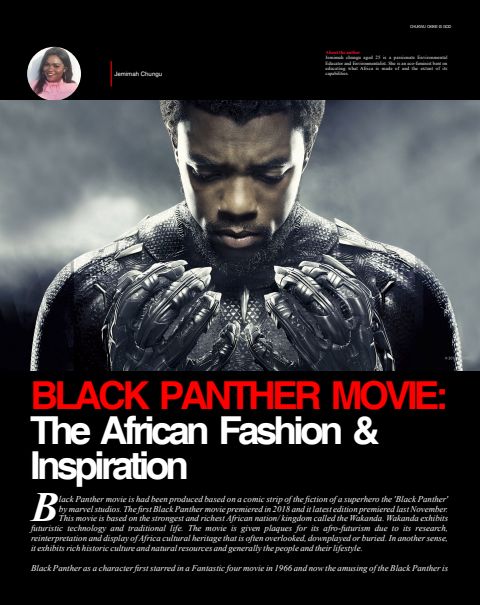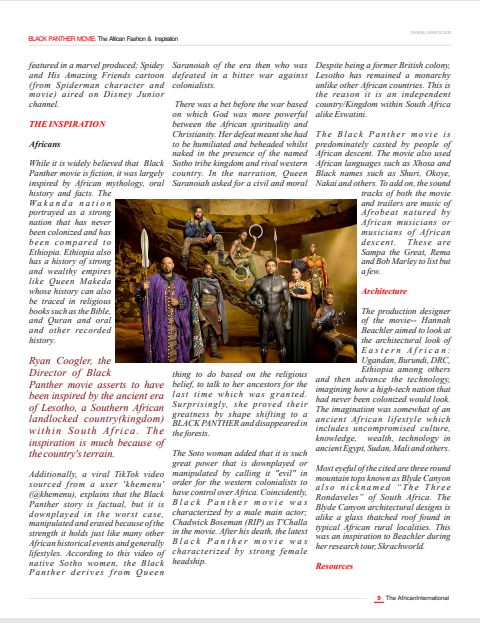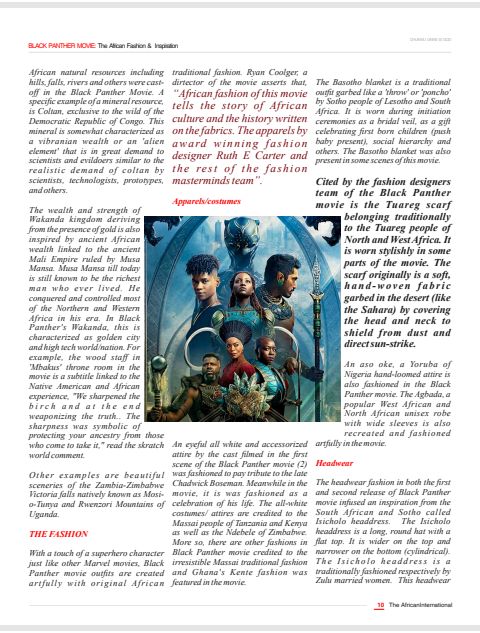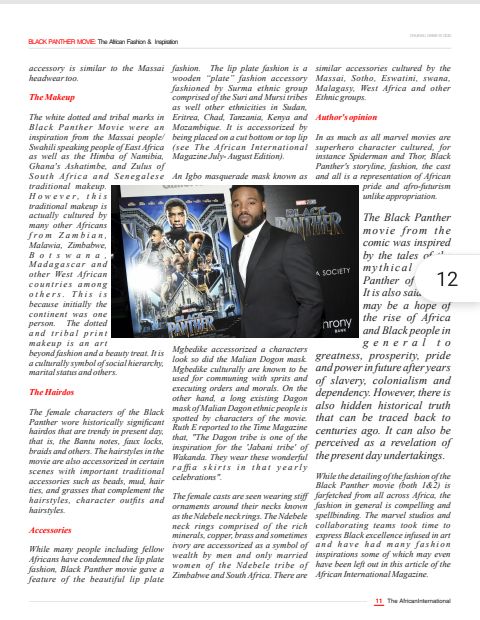By: Jemimah Chungu

Black Panther movie is had been produced based on a comic strip of the fiction of a superhero the ‘Black Panther’ by marvel studios. The first Black Panther movie premiered in 2018 and it latest edition premiered last November. This movie is based on the strongest and richest African nation/ kingdom called the Wakanda. Wakanda exhibits futuristic technology and traditional life. The movie is given plaques for its afro-futurism due to its research, reinterpretation and display of Africa cultural heritage that is often overlooked, downplayed or buried. In another sense, it exhibits rich historic culture and natural resources and generally the people and their lifestyle.
Black Panther as a character first starred in a Fantastic four movie in 1966 and now the amusing of the Black Panther is featured in a marvel produced; Spidey and His Amazing Friends cartoon (from Spiderman character and movie) aired on Disney Junior channel.

THE INSPIRATION
Africans
While it is widely believed that Black Panther movie is fiction, it was largely inspired by African mythology, oral history and facts. The Wakanda nation portrayed as a strong nation that has never been colonized and has been compared to Ethiopia. Ethiopia also has a history of strong and wealthy empires like Queen Makeda whose history can also be traced in religious books such as the Bible, and Quran and oral and other recorded history.
Ryan Coogler, the Director of Black Panther movie asserts to have been inspired by the ancient era of Lesotho, a Southern African landlocked country(kingdom) within South Africa. The inspiration is much because of the country’s terrain.
Additionally, a viral TikTok video sourced from a user ‘khemenu’ (@khemenu), explains that the Black Panther story is factual, but it is downplayed in the worst case, manipulated and erased because of the strength it holds just like many other African historical events and generally lifestyles. According to this video of native Sotho women, the Black Panther derives from Queen Saranoiah of the era then who was defeated in a bitter war against colonialists.
There was a bet before the war based on which God was more powerful between the African spirituality and Christianity. Her defeat meant she had to be humiliated and beheaded whilst naked in the presence of the named Sotho tribe kingdom and rival western country. In the narration, Queen Saranoiah asked for a civil and moral thing to do based on the religious belief, to talk to her ancestors for the last time which was granted. Surprisingly, she proved their greatness by shape shifting to a BLACK PANTHER and disappeared in the forests.
The Soto woman added that it is such great power that is downplayed or manipulated by calling it “evil” in order for the western colonialists to have control over Africa. Coincidently, Black Panther movie was characterized by a male main actor; Chadwick Boseman (RIP) as T’Challa in the movie. After his death, the latest Black Panther movie was characterized by strong female headship.
Despite being a former British colony, Lesotho has remained a monarchy unlike other African countries. This is the reason it is an independent country/Kingdom within South Africa alike Eswatini.
The Black Panther movie is predominately casted by people of African descent. The movie also used African languages such as Xhosa and Black names such as Shuri, Okoye, Nakai and others. To add on, the sound tracks of both the movie and trailers are music of Afrobeat natured by African musicians or musicians of African descent. These are Sampa the Great, Rema and Bob Marley to list but a few.
Architecture
The production designer of the movie– Hannah Beachler aimed to look at the architectural look of Eastern African: Ugandan, Burundi, DRC, Ethiopia among others and then advance the technology, imagining how a high-tech nation that had never been colonized would look. The imagination was somewhat of an ancient African lifestyle which includes uncompromised culture, knowledge, wealth, technology in ancient Egypt, Sudan, Mali and others.
Most eyeful of the cited are three round mountain tops known as Blyde Canyon also nicknamed “The Three Rondaveles” of South Africa. The Blyde Canyon architectural designs is alike a glass thatched roof found in typical African rural localities. This was an inspiration to Beachler during her research tour, Skrachworld.
Resources

African natural resources including hills, falls, rivers and others were cast-off in the Black Panther Movie. A specific example of a mineral resource, is Coltan, exclusive to the wild of the Democratic Republic of Congo. This mineral is somewhat characterized as a vibranian wealth or an ‘alien element’ that is in great demand to scientists and evildoers similar to the realistic demand of coltan by scientists, technologists, prototypes, and others.
The wealth and strength of Wakanda kingdom deriving from the presence of gold is also inspired by ancient African wealth linked to the ancient Mali Empire ruled by Musa Mansa. Musa Mansa till today is still known to be the richest man who ever lived. He conquered and controlled most of the Northern and Western Africa in his era. In Black Panther’s Wakanda, this is characterized as golden city and high tech world/nation. For example, the wood staff in ‘Mbakus’ throne room in the movie is a subtitle linked to the Native American and African experience, “We sharpened the birch and at the end weaponizing the truth.. The sharpness was symbolic of protecting your ancestry from those who come to take it,” read the skratch world comment.
Other examples are beautiful sceneries of the Zambia-Zimbabwe Victoria falls natively known as Mosi-o-Tunya and Rwenzori Mountains of Uganda.

THE FASHION
With a touch of a superhero character just like other Marvel movies, Black Panther movie outfits are created artfully with original African traditional fashion. Ryan Coolger, a dirtector of the movie asserts that, “African fashion of this movie tells the story of African culture and the history written on the fabrics. The apparels by award winning fashion designer Ruth E Carter and the rest of the fashion masterminds team”.
Apparels/costumes
An eyeful all white and accessorized attire by the cast filmed in the first scene of the Black Panther movie (2) was fashioned to pay tribute to the late Chadwick Boseman. Meanwhile in the movie, it is was fashioned as a celebration of his life. The all-white costumes/ attires are credited to the Massai people of Tanzania and Kenya as well as the Ndebele of Zimbabwe. More so, there are other fashions in Black Panther movie credited to the irresistible Massai traditional fashion and Ghana’s Kente fashion was featured in the movie.
The Basotho blanket is a traditional outfit garbed like a ‘throw’ or ‘poncho’ by Sotho people of Lesotho and South Africa. It is worn during initiation ceremonies as a bridal veil, as a gift celebrating first born children (push baby present), social hierarchy and others. The Basotho blanket was also present in some scenes of this movie.
Cited by the fashion designers team of the Black Panther movie is the Tuareg scarf belonging traditionally to the Tuareg people of North and West Africa. It is worn stylishly in some parts of the movie. The scarf originally is a soft, hand-woven fabric garbed in the desert (like the Sahara) by covering the head and neck to shield from dust and direct sun-strike.
An aso oke, a Yoruba of Nigeria hand-loomed attire is also fashioned in the Black Panther movie. The Agbada, a popular West African and North African unisex robe with wide sleeves is also recreated and fashioned artfully in the movie.
Headwear
The headwear fashion in both the first and second release of Black Panther movie infused an inspiration from the South African and Sotho called Isicholo headdress. The Isicholo headdress is a long, round hat with a flat top. It is wider on the top and narrower on the bottom (cylindrical). The Isicholo headdress is a traditionally fashioned respectively by Zulu married women. This headwear accessory is similar to the Massai headwear too.
The Makeup
The white dotted and tribal marks in Black Panther Movie were an inspiration from the Massai people/ Swahili speaking people of East Africa as well as the Himba of Namibia, Ghana’s Ashatimbe, and Zulus of South Africa and Senegalese traditional makeup. However, this traditional makeup is actually cultured by many other Africans from Zambian, Malawia, Zimbabwe, Botswana, Madagascar and other West African countries among others. This is because initially the continent was one person. The dotted and tribal print makeup is an art beyond fashion and a beauty treat. It is a culturally symbol of social hierarchy, marital status and others.
The Hairdos
The female characters of the Black Panther wore historically significant hairdos that are trendy in present day, that is, the Bantu notes, faux locks, braids and others. The hairstyles in the movie are also accessorized in certain scenes with important traditional accessories such as beads, mud, hair ties, and grasses that complement the hairstyles, character outfits and hairstyles.
Accessories
While many people including fellow Africans have condemned the lip plate fashion, Black Panther movie gave a feature of the beautiful lip plate fashion. The lip plate fashion is a wooden “plate” fashion accessory fashioned by Surma ethnic group comprised of the Suri and Mursi tribes as well other ethnicities in Sudan, Eritrea, Chad, Tanzania, Kenya and Mozambique. It is accessorized by being placed on a cut bottom or top lip (see The African International Magazine July- August Edition).
An Igbo masquerade mask known as Mgbedike accessorized a characters look so did the Malian Dogon mask. Mgbedike culturally are known to be used for communing with sprits and executing orders and morals. On the other hand, a long existing Dagon mask of Malian Dagon ethnic people is spotted by characters of the movie. Ruth E reported to the Time Magazine that, “The Dagon tribe is one of the inspiration for the ‘Jabani tribe’ of Wakanda. They wear these wonderful raffia skirts in that yearly celebrations”.
The female casts are seen wearing stiff ornaments around their necks known as the Ndebele neck rings. The Ndebele neck rings comprised of the rich minerals, copper, brass and sometimes ivory are accessorized as a symbol of wealth by men and only married women of the Ndebele tribe of Zimbabwe and South Africa. There are similar accessories cultured by the Massai, Sotho, Eswatini, swana, Malagasy, West Africa and other Ethnic groups.
Author‘s opinion
In as much as all marvel movies are superhero character cultured, for instance Spiderman and Thor, Black Panther’s storyline, fashion, the cast and all is a representation of African pride and afro-futurism unlike appropriation.
The Black Panther movie from the comic was inspired by the tales of the mythical Black Panther of Africa. It is also said that it may be a hope of the rise of Africa and Black people in general to greatness, prosperity, pride and power in future after years of slavery, colonialism and dependency. However, there is also hidden historical truth that can be traced back to centuries ago. It can also be perceived as a revelation of the present day undertakings.
While the detailing of the fashion of the Black Panther movie (both 1&2) is farfetched from all across Africa, the fashion in general is compelling and spellbinding. The marvel studios and collaborating teams took time to express Black excellence infused in art and have had many fashion inspirations some of which may even have been left out in this article of the African International Magazine.

